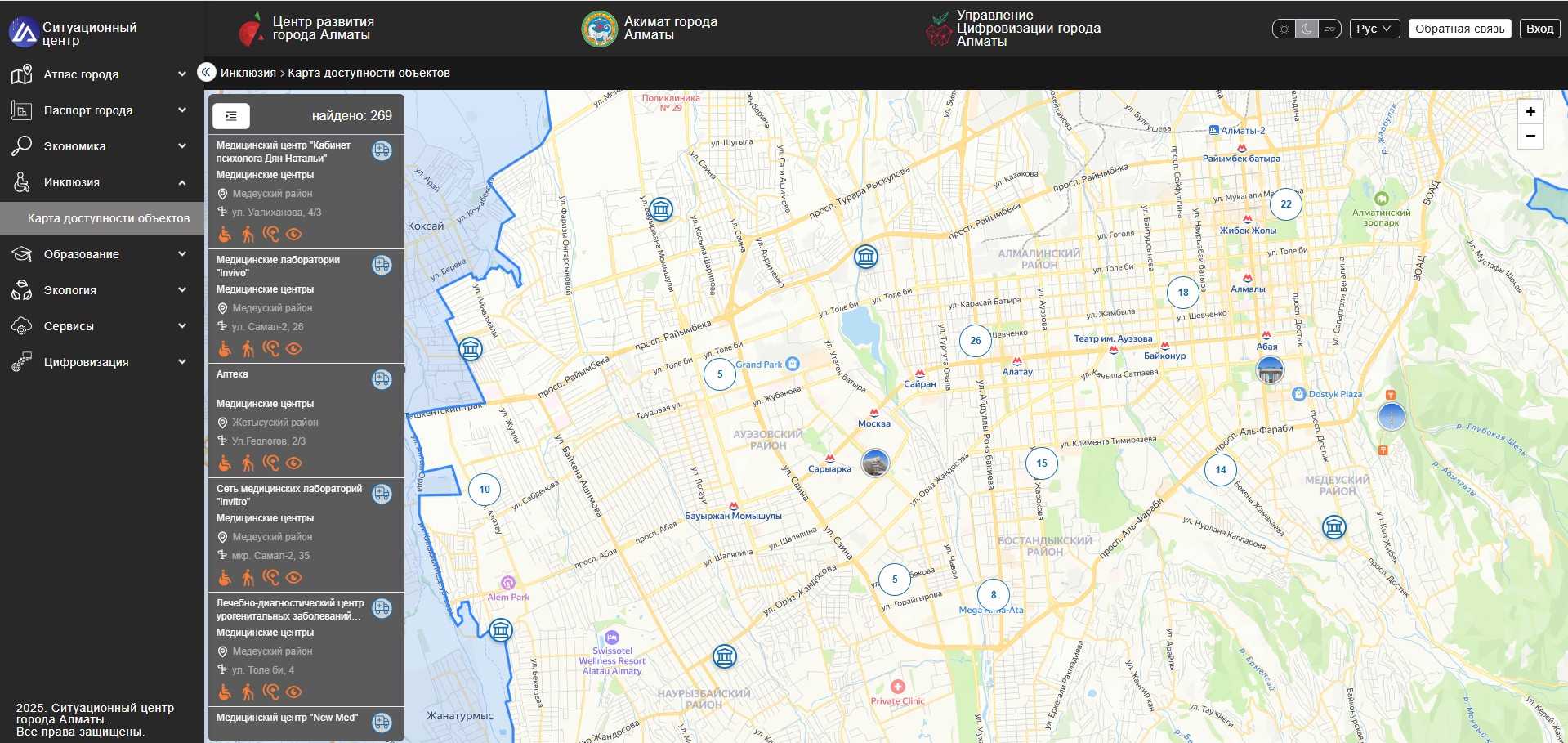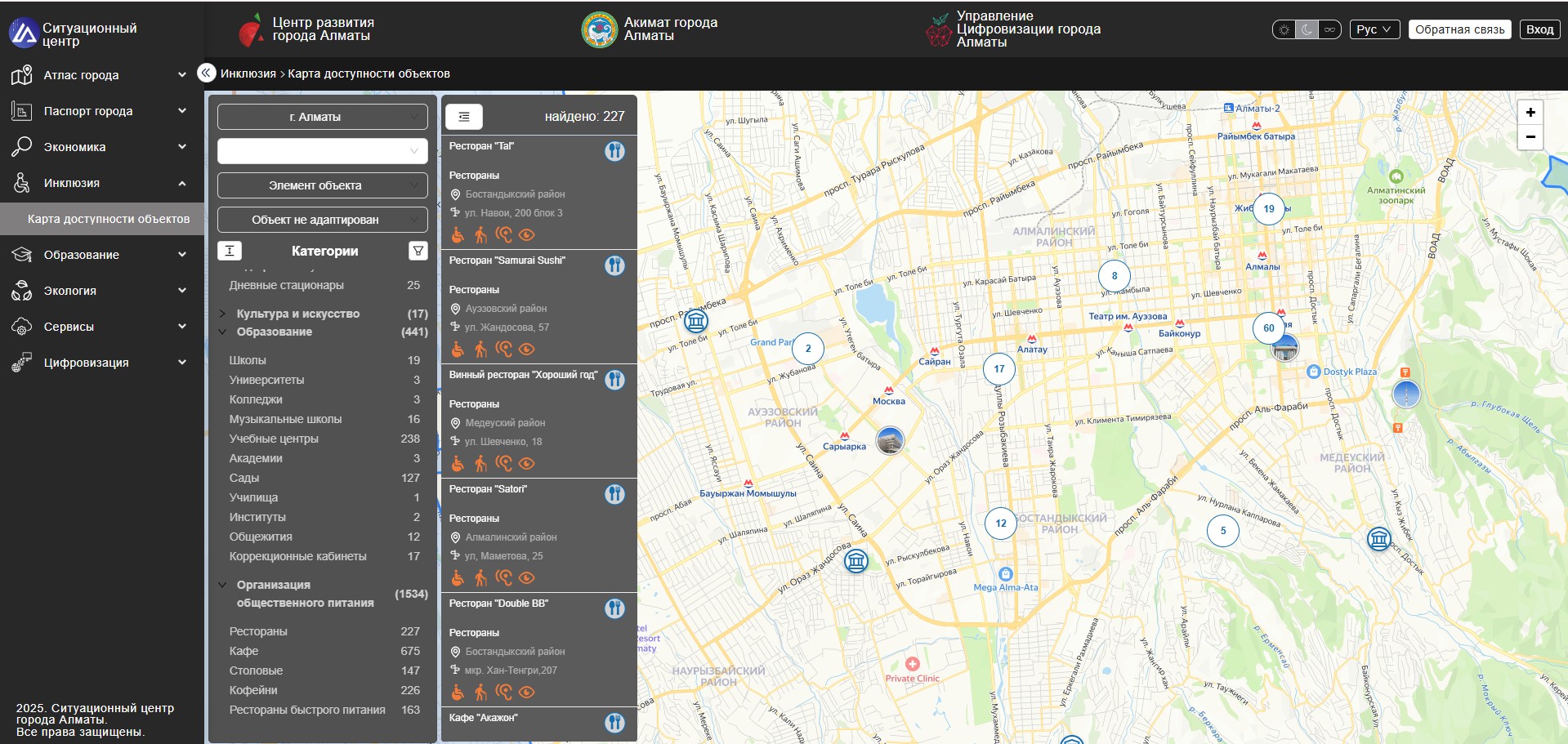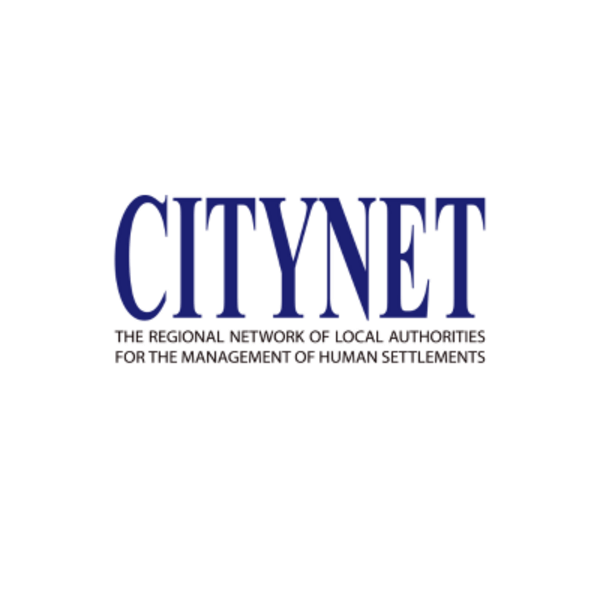 Medical Centres - © City Goverment of Almaty
Medical Centres - © City Goverment of Almaty Restaurants - © City Goverment of Almaty
Restaurants - © City Goverment of Almaty
City
Almaty
Main actors
City Government, NGO / Philanthropy, Community / Citizen Group
Project area
Whole City/Administrative Region
Duration
Ongoing since 2022
Digital Inclusion is a smart city solution designed to support the systematic evaluation and communication of urban accessibility for all residents of Almaty. The project was implemented by Almaty Development Centre in collaboration with the City’s Departments of Digitalization and Social Programs. Approximately 10–15 staff were involved, including IT specialists, inspectors, and analysts. Coordination was ensured through a dedicated working group and the involvement of the Situational and Analytical Centre. NGOs and accessibility experts also contributed during the design phase. From the outset, the initiative was designed with these SDG principles in mind. It aligns with Kazakhstan’s national commitments to the 2030 Agenda, particularly in promoting inclusive urban development, digital governance, and human rights protection for vulnerable groups.
This is an abbreviated version of the original case study on the Urban SDG Knowledge Platform with information provided by the City Government of Almaty.
Almaty is Kazakhstan’s largest city and economic centre, with a population exceeding 2 million residents and a mountainous landscape that presents both geographic constraints and urban density challenges. As a legacy of the Soviet-era planning system, much of Almaty’s public infrastructure was not designed with universal accessibility in mind. Despite national legislation mandating barrier-free environments, there was no reliable mechanism to monitor the actual state of physical accessibility or inform the public about which facilities and areas are adapted to the needs of persons with disabilities.
This gap in implementation created serious obstacles for people with visual, hearing, or mobility impairments—limiting their ability to move freely, access public services, and participate fully in city life. Moreover, the absence of centralized, real-time data made it difficult for city authorities to plan, prioritize, and budget for necessary improvements.
The Digital Inclusion initiative was designed to address these systemic challenges by introducing a city-wide digital platform to assess, visualize, and communicate accessibility levels across urban infrastructure. It aims to transform accessibility from a compliance requirement into a visible, measurable, and publicly shared responsibility.
This digital approach was chosen for its scalability, transparency, and adaptability. It allows inspectors to collect data in the field using mobile-friendly forms, which are uploaded into a centralized database. An interactive online map then communicates the accessibility status of public facilities to citizens in a user-friendly format. The platform also includes an analytics module that supports data-driven planning and policymaking.
The key objectives of the initiative include:
- Establishing a standardized, digital inspection and monitoring system for accessibility compliance;
- Providing a publicly accessible map of facilities, categorized by disability type (visual, hearing, mobility, musculoskeletal);
- Enabling real-time feedback loops between inspectors, government departments, and residents;
- Supporting inclusive urban planning by providing data insights to policymakers;
- Empowering citizens—especially those with disabilities—to make informed decisions and advocate for inclusive environments.
The Digital Inclusion initiative was launched in 2022 and implemented in several key phases to ensure both technical functionality and community relevance. The implementation was led by the Almaty Development Centre in collaboration with the city’s Department of Digitalization and the Department of Employment and Social Programs.
Key Actions and Stages:
Design and Development Phase
The project began with the development of a digital platform integrating three core components: (1) a mobile-compatible inspection interface for field data collection; (2) an interactive public map showing the accessibility status of urban objects; and (3) an analytics dashboard for city officials. Accessibility criteria were developed in alignment with Kazakhstan’s national regulations and structured across four user profiles: individuals with visual, hearing, mobility, and musculoskeletal impairments.
Pilot and Field Testing
A pilot program was launched to assess key facilities such as hospitals, schools, administrative buildings, and public transport infrastructure. A dedicated team of certified accessibility inspectors conducted on-site audits using the mobile system, collecting standardized data on over 15,000 public facilities.
Public Launch and Platform Deployment
Following testing and refinement, the platform was made publicly accessible via a city-run web portal. Residents could view facility information, filter results by disability type, and make informed decisions about safe and accessible routes.
Citizen Engagement
The initiative incorporated participatory elements from the start. NGOs and civil society organizations were consulted during the design phase. Later, a feature was introduced allowing citizens to submit their own accessibility assessments via structured online questionnaires. These inputs complement official data and enhance the geographic reach of the project.
Monitoring and Evaluation
The system includes automated data validation, periodic audit refresh cycles, and performance indicators tracking inspection frequency, facility adaptation status, and citizen feedback. The analytics dashboard supports regular reporting for city departments and aligns with budgeting and planning cycles.
Mid- and Long-Term Strategy:
To sustain the initiative, the city is investing in:
- Development of a dedicated mobile app to enhance real-time public interaction;
- Integration of accessibility data into urban planning tools and smart city dashboards;
- Introduction of an algorithm-based prioritization tool for infrastructure investments;
- Ongoing training and expansion of the inspector network;
- Strengthening partnerships with civic tech and disability rights organizations.
Most Innovative Aspects:
- Disability-specific categorization of accessibility data enables personalized decision-making for residents;
- Real-time, open-access digital map bridges transparency, governance, and civic empowerment;
- Modular and scalable architecture, allowing replication by other cities with minimal infrastructure investment;
- Citizen-led evaluations create a feedback loop between public and government actors, enhancing trust and accountability.
The initiative exemplifies a shift from static compliance to dynamic, inclusive, and data-driven urban management.
The Digital Inclusion initiative was financed entirely through the local budget of the City of Almaty, without any external donor or private sector funding. The initiative was implemented under the coordination of the Almaty Development Centre, with close collaboration from the Department of Digitalization and the Department of Employment and Social Programs.
Capital and Operating Resources Included
- Development of a custom digital platform with three core components: a mobile inspection interface, a public-facing interactive accessibility map, and an analytics dashboard for city officials;
- Use of existing municipal IT infrastructure and cloud-based services;
- Procurement and configuration of mobile devices for inspectors;
- Ongoing platform maintenance, content updates, and user support.
Internal Resources
- A multidisciplinary team of municipal staff including software developers, data analysts, accessibility specialists, and project managers;
- Certified accessibility inspectors conducting on-site evaluations across public facilities;
- Policy and planning staff from relevant city departments contributing to oversight and integration.
External Contributions
- No financial or donor-based support was involved;
- However, technical consultations and user testing were supported by civil society organizations and members of the disability community on a voluntary basis.
Data and Technology
- The platform is built on web-based and GIS-integrated architecture;
- Data from national accessibility standards and Almaty’s city infrastructure inventories were used to guide inspections and system logic;
- Open-source tools were leveraged where feasible to reduce long-term operating costs.
Financial Outcomes
While not revenue-generating, the initiative has improved operational efficiency by digitizing inspection workflows and enabling data-informed planning. It contributes to cost-effective public investment by helping prioritize infrastructure upgrades based on real accessibility needs. Moreover, it enhances the city’s reputation as a transparent and inclusive urban innovator.
Since its launch, the Digital Inclusion platform has become a key instrument for improving urban accessibility and inclusive governance in Almaty. As of mid-2025, the system includes verified data on over 15,000 public facilities, evaluated across four categories of disability: visual, hearing, mobility, and musculoskeletal impairments.
Achievements and Beneficiaries
- The platform directly benefits persons with disabilities, elderly residents, and caregivers by offering real-time, location-specific data to plan accessible routes and access public services.
- City planners and public officials use the data for infrastructure prioritization and compliance monitoring.
- Civil society organizations and accessibility advocates use the open data for campaigns and policy advocacy.
Measurement of Success
- Quantitative: over 15,000 locations inspected, with updated status indicators on the digital map.
- Qualitative: increased public awareness, visibility of accessibility issues, and institutional integration into city planning processes.
- User feedback and ongoing updates serve as continuous evaluation mechanisms.
Contributing Factors
- Strong interdepartmental collaboration (digitalization, social programs, planning).
- Political will and alignment with national accessibility laws.
Support for Marginalized Groups
The initiative is specifically designed to address structural barriers faced by people with disabilities, one of the most underserved populations in urban environments. By highlighting gaps and progress publicly, the project promotes equity and civic dignity.
Estimated Impact
- Direct beneficiaries: approximately 60,000–80,000 people in Almaty with registered disabilities.
- Indirect beneficiaries: over 1 million residents, including elderly citizens, caregivers, families with children, and those involved in urban design and governance.
Contribution to Liveability
The platform improves the city’s liveability by:
- Making accessibility visible, actionable, and accountable;
- Enhancing physical mobility, personal autonomy, and public trust;
- Supporting a data-driven approach to equitable urban investment;
- Fostering inclusive urban environments that align with global SDG goals and local aspirations for smart, citizen-centred development.
- Technical challenge: ensuring data consistency across large datasets.
- Social challenge: encouraging sustained civic participation in inspections and feedback.
The Digital Inclusion platform was intentionally designed with replication and scalability in mind. Its architecture is modular, low-cost, and adaptable, allowing other cities or municipalities—regardless of size or digital maturity—to adopt and tailor it to their local needs.
Replicability Potential
- The system is built on open, web-based technology, requiring only basic IT infrastructure and GIS capabilities. It does not demand high-end hardware or complex integrations, making it suitable even for small or resource-constrained cities.
- It is policy-neutral and can be easily aligned with local accessibility standards or legal frameworks in other countries or jurisdictions.
- The disability classification model and inspection forms can be localized or expanded based on regional disability categories and facility types.
Best-Suited Contexts for Replication
- Urban areas seeking to comply with national or international accessibility mandates.
- Cities implementing smart city frameworks, open data policies, or digital transformation agendas.
- Local governments that aim to improve citizen trust, transparency, and inclusive service delivery.
Key Lessons for Replication
- Start small: a pilot phase with high-priority facilities helps validate the methodology and build trust.
- Engage stakeholders early: include persons with disabilities, inspectors, NGOs, and municipal departments in the design process.
- Design for usability: the interface must be accessible not just physically, but also digitally (e.g., for people with visual impairments or low digital literacy).
- Create feedback loops: allowing public input adds value and legitimacy to the data.
Scalability Prospects
- The system can be scaled horizontally (to cover more urban facilities and districts) and vertically (by integrating additional services such as reporting tools, route planning, or mobile navigation support).
- The model can also be repurposed for related areas—such as age-friendly infrastructure, gender-sensitive design, or climate resilience—by modifying the data structure and evaluation criteria.
Current Replication Status
While the initiative is currently focused on Almaty, preliminary discussions are underway to extend similar practices to other municipalities in Kazakhstan. The project team is also open to cross-border knowledge sharing with interested cities in Central Asia and beyond.
In short, Digital Inclusion offers not only a local innovation but a scalable and transferable model for inclusive, data-driven urban governance worldwide.
On Map
The Map will be displayed after accepting cookie policy

